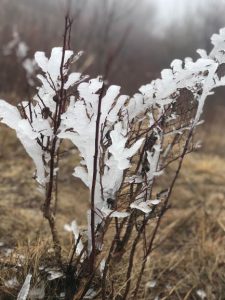
Over Spring Break last week, my daughter and I road tripped to western North Carolina to visit a lifelong friend and her family. My aunt and uncle also live in the area, and we were able to squeeze in a short visit with them. On a steering wheel-gripping, steep, and curvy drive to their home halfway up a mountain, I started wondering what it must be like to drive that road in the winter. Talking with them, they mentioned being around 3000 feet in elevation, and are just below the typical snow line. But sometimes they can see a line of “rime ice” above them, encircling the mountain. I was unfamiliar with the term, and they explained that rime ice is essentially frozen fog. The Appalachian Mountains get their nickname, the “Smokies,” from the nearly year-round fog that settles in the valleys from the constant transpiration of trees in thick forests. During winter in areas over 3000 feet above sea level, the water droplets are supercooled and the fog will freeze, creating a winter wonderland of thick, spiky ice on vegetation and buildings.

Having learned something new, I was intrigued but never expected to experience this phenomenon in late March. The next day, my friend took us on a hike to Black Balsam, a peak that climbs over 6200 feet. As soon as we entered the trailhead, we were delighted to see there were ice-covered fir trees as far as the eye could see. This was the very “rime ice” we had learned of the day before. When the wind rustled, shards of ice dropped on our heads, littering the cold ground with pieces like broken glass.

As we climbed higher, we saw that nearly every shrub and tree had thick layers of toothed ice crystals on their windward sides. The views atop the mountain were obscured by fog, but the ice was exciting enough for us Floridians!
Rime ice occurs in higher elevations worldwide, and the same phenomenon can happen when planes fly through freezing clouds. Pilots must be aware of ice accumulating on the aircraft, which can create drag or damage the plane.
 0
0
